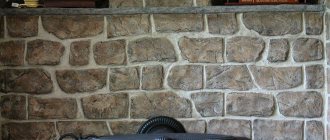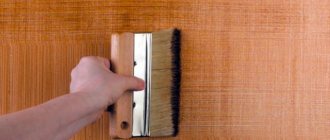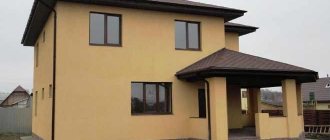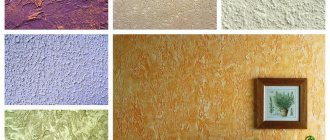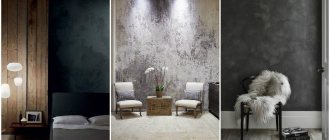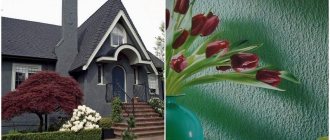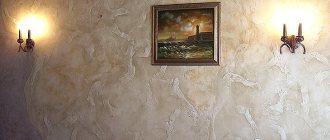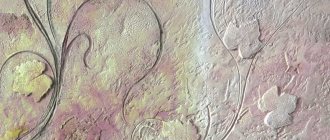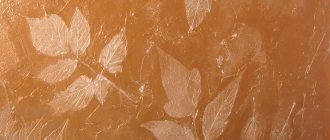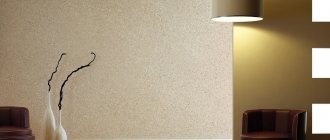Velvet-look decorative plaster has an original design and is optimal for creating custom interiors in the Baroque, Classic, and Rococo styles. The composition can be used for finishing walls, ceilings and zoning spaces. Plaster with silver, pearlescent shades is in demand.
Silk walls
The Chinese Empire gave the world amazing fabric. Light, delicate, amazingly beautiful material quickly gained popularity in many countries. Of course, we are talking about silk - one of the most ancient and expensive fabrics.
The nobility and nobility in Russia, Europe and the East decorated the rooms of their palaces and mansions with silk fabric.
As already mentioned, such a whim was intended not only to give the interior an aesthetic appearance, but also to show the status of the owner. Indeed, due to the high cost of fabric, such pleasure was available to a rather narrow circle of people, including members of royal families.
Now everyone can afford such pleasure. This became possible thanks to special paint.
Painting materials for walls with the effect of silk fabric make you feel like you are in an imperial palace, even if you live in an ordinary city apartment. The effect of silk-covered walls is so complete that you constantly want to touch the surface.
Natural shine, as well as imitation of real silk fabric, is achieved using special paint components. But it is no less important in this matter to correctly apply painting and priming materials to the surface to be painted.
How to achieve a velvet effect
To decorate surfaces that imitate luxurious fabric, decorative velvet plaster is used. The main advantages of the finishing material are:
- Practicality;
- rich shade range;
- long service life;
- aesthetic appearance.
When using decorative velvet plaster, it is important to adhere to the technology of its correct application to the surface. Unlike the conventional method of applying plaster, achieving a velvet effect is a little more difficult.
A velvet coating can only be achieved by using special thin-layer decorative plasters or paints.
The secret lies in the number of layers applied, which should be 3-4. The layers are applied with a special round trowel.
As a result of the work carried out, it is possible to achieve a beautiful matte finish with soft tints, creating the effect of velvet drapery.
This decoration will look harmonious in the interior of rooms decorated in baroque or shabby chic style. Velvet curtains will give the room a finished look.
Silk effect paint composition
The natural silk effect paint contains the following components:
- Acrylic resin.
- Pearlescent pigment.
- Water.
Silk paint belongs to the latest generation of interior solutions. This means that the composition of the coloring material is as environmentally friendly and safe for health as possible.
Silk effect wall paint. Photo
A clear example of this is the lack of solvent in the paint. It is replaced by water, and therefore the paint is harmless and can be used without causing an allergy to the solvent.
The binding material in this paint is acrylic resin. It gives the coloring substance the necessary viscosity and reduces spreading. Silk fabric effect paint is very convenient to apply to walls.
And finally, the most important paint pigment, which is responsible for the stunning “fabric” effect - pearlescent pigment. Pigment particles in paint are capable of reflecting light. Due to this, the effect of natural silk on the walls is achieved, playing with many color tints.
In addition, pigment particles give painted walls another interesting feature. The color of the paint will change depending on the lighting in the room and the viewing angle! For example, a person passing by a “silk” wall will observe the play of paint colors. Natural or artificial light will also change the perception of color.
If the coating is applied correctly, using all the necessary means, the paint will look very realistic. Your guests will not be able to visually distinguish natural silk from a painted wall. To understand the difference, they will need to touch the painted surface and see for themselves the amazing effect.
Step-by-step application instructions
Stages of applying velvet plaster:
- The paint is prepared, the jar is shaken, the composition is thoroughly mixed to obtain a uniform tinting of the surface.
- Tint dye and water (up to 10-20% of the total composition) are added to the container, and the mass is mixed.
- At the next stage, putty and dye are applied to the surface. Work begins with hard-to-reach areas of the room. It is optimal to first treat areas near doors, windows, and paint corners. For high-quality application of plaster, you need a brush no more than 3 cm wide.
- After painting difficult areas, plaster with color is applied to the remaining surfaces. The work uses a special velor roller. Movements must be careful; unpainted areas or excessive application of the mixture are unacceptable.
- To evenly distribute the dye with the plaster, you need to roll out the roller in a special tray. Then the wall panels are processed.
- Plastered surfaces dry in 24-36 hours. The exact time, taking into account temperature conditions and air humidity, is indicated on the packaging.
- After the background coating has dried, putty is applied to the walls using a trowel. The composition is placed on the working part of the tool, transferred to the wall and leveled.
- To enhance the velvet effect, a second layer of putty must be applied to the surface.
Types of silk effect paints
In the market of paints and varnishes, decorative paints of this kind are especially distinguished. Most often they are intended for finishing interiors that claim to be rich and luxurious apartments.
Silk effect paint. Photo.
There are several types of “silk” paints.
- Pearlescent paints with a metallic shine effect. The color range is represented by a rich selection of the most noble shades: gold, silver and bronze. The paint is applied in several layers. Only if all the rules are followed correctly will the last layer sparkle with the desired color.
- Chameleon paint or paint with a wet silk effect. As the name suggests, at different viewing angles, the painted surface will sparkle with different colors. The main tone of the paint is provided by the primer or substrate. And on top they are covered with sparkling pigments.
- Granular mosaic paint. This type is used to emphasize individual objects or details in a setting.
In any case, no matter what type of paint you choose, the design of your premises will turn out to be very stylish, unusual and even luxurious.
Required tools and materials
In order to create a covering on the wall that imitates velvet fabric, you need a set of tools and building materials available to everyone:
- Special primer. It is better if it contains quartz sand or another element with a fine-grained structure.
- Decorative emulsion. The construction market offers a wide selection of such paint from not only domestic but also foreign manufacturers. At the same time, both materials are of high quality.
- Varnish. The use of this coating is optional. But applying a layer of matte or clear varnish will create additional protection on the wall surface and enhance the effect of the paint. The coating will become impervious to moisture.
- Color. It is necessary because the emulsion is produced in white color. Using color, the velvet-effect coating is given a shade that matches the overall design idea and harmonizes with the decor in the room.
- A roller with medium pile for priming the wall.
- A spatula, wide brush or sponge for painting walls and giving them the desired texture.
- A trowel for finishing a painted surface.
After acquiring all the necessary components, you can begin to create a spectacular coating on the wall.
Velvet paints
The most practical and fairly cheap finishing material can be considered wall paint. Ceiling and wall paint are now widely used for interior decoration. Indeed, it is practical and at the same time beautiful and stylish.
Some time ago the situation was exactly the opposite. Paint was not used due to the limited color range. The traditional way to decorate walls was to cover them with wallpaper.
In modern conditions the situation is completely different. The difficulty in choosing paint arises only because of the huge selection, the difficulty of giving preference to any color. And the functional purpose of the walls has also changed; they are now only a background for creating an interior, and not decoration - as was previously thought. Naturally, you need to create a decent foundation in order to then create a unique room design with a pleasant atmosphere.
Decorative interior paints have attracted a lot of attention. Therefore, the development of this area is proceeding very quickly. There are a lot of modern compounds with various properties. For example, velvet paint. It is a fairly fashionable variation of paint and varnish products. After treatment with velvet paint, the wall takes on a stunning look. It seems that the wall has a fabric surface.
This paint has a special micro-grain structure, resulting in a velvety effect. Depending on what result we want to achieve - fine or coarse, we select the appropriate type of painting material.
Already now you can find a large number of types of velvet paint. The variety of colors, of course, will not leave anyone indifferent. There is also a large selection of textures available. The softness or roughness of a painted surface depends on additives, the structure of which varies.
Velvet paint will not cause problems in work. The only thing you need to pay attention to is the base being painted. The wall you plan to paint needs to be prepared in advance. Defects and surface unevenness must first be repaired and leveled.
Painting features
The method of applying velvet coating differs from using standard paint and requires some skill. The final result directly depends on following the correct technique for applying paintwork, including all successive stages.
Surface preparation
The paint is applied to a previously leveled wall, treated with putty and primed. Before applying the composition, it is recommended to prepare the walls: eliminate roughness, clean the surface from traces of dust.
Minor flaws are acceptable when applying textured paint: cracks and irregularities will be filled with a dense composition of the paint and varnish.
Required tools and materials
To work you will need:
- paint roller
- thin brush for joints
- brush with a long curved handle
- medium spatula
- plaster trowel
- paint tray
Sequence and application technique
The process of painting walls includes the following algorithm of actions:
- Treat the wall surface with acrylic primer
- Add the required amount of pigment to the paint and mix the composition thoroughly. If necessary, you can dilute the mixture a little with water. Pour the required amount of paint into the tray
- First of all, using a thin brush, paint the sections of the wall adjacent to the cornices, baseboards, as well as the corners
- Using a paint roller with a long handle, the main surface is processed, onto which a thin layer of paint is applied. Hard-to-reach areas (areas behind radiators, etc.) require the use of a brush with a long curved handle. The paint is applied at a temperature of +5…+30°С
- The base coat of paint needs time to dry before the texture coat can be applied.
- The mixture for subsequent decorative layers is poured into a tray, from where it is scooped up with a spatula and applied to the trowel.
- The first decorative layer should cover the wall surface thinly and smoothly, which will provide a reflective effect and a basic velvety feel after drying.
- The next layer is denser; the paint is spread with a trowel using chaotic strokes and circular movements to create a relief pattern imitating a velvet sheen.
- After the second layer of decorative mixture has dried, the surface is treated with a trowel.
Painting features, depending on the paint manufacturer, may include the application of a fixing varnish as the final layer. The varnish coating visually enhances the effect of the velvety texture, depth and richness of the shade. Additionally protects the surface from the negative effects of moisture and ultraviolet radiation. The varnish can be applied in 1 or 2 layers.
Application of velvet paint
Before you start working with velvet paint, there are some basic rules to remember. The main ones are listed below:
Surface preparation
We carefully prepare the surface. We check how smooth the wall is. If there are depressions and bulges, be sure to putty, then sand it, and finally clean it from dust. Now we treat it with an acrylic primer and dry it.
Do not dilute
Wall and ceiling velvet paint is sold in prepared form. It is packaged in metal cans or plastic buckets. We purchase paint of the shade you need, because if you try to add color to change the shade, nothing good will come of it, the paint will be damaged.
Applying paint
For an even application of decorative velvet paint, it is best to use a paint sprayer. Due to the high cost of paint sprayers, it is not rational to purchase them for painting a small area. The most economical option would be to rent this tool - a similar service is widely offered by many construction companies and large stores. If you couldn’t find a paint sprayer, you can use a brush with artificial fiber to prevent swelling from water. It is good to use a microfiber roller.
Using a spray gun
It is better to apply paint to the wall from a distance of three to five centimeters. You need to try to move the spray gun carefully along the wall, try to achieve uniform coloring.
Number of layers
The best result is obtained with a two-layer paint application. Moreover, the first time we apply the paint horizontally, let it dry for two to three hours, and paint it vertically. If errors occur - unpainted areas, uneven shine - it is better to paint a third time.
Strengthening compounds
We remember about pre-treatment of the surface - it is already prepared:
- durable,
- clean,
- dry,
- low fat.
For greater reliability, we impregnate it with strengthening compounds.
So, using velvet paint will transform your room. I would especially like to note its high consumer characteristics - environmental friendliness, the ability to “breathe”, that is, to allow steam and moisture to pass through, as well as resistance to abrasion.
Choice of color or tinting
Dark-colored plaster is used to decorate rich interiors. Light shades are used to create a light interior character.
The mixtures are sold ready-made in buckets. They are tinted to the desired shade in the store in front of you, using a special computer program.
Colors are selected based on the future design of the room:
- High-tech - gray metallic, snow-white, charcoal;
- Provence - creamy, caramel, blue;
- loft - turquoise, emerald, light green, red shades;
- Baroque - soft pastel colors;
- eco-style - sand, brown colors;
- modern - lilac, blue, green;
- classic style - white and its shades, brown tones.
The choice of plaster colors depends on the purpose of the room:
- Warm shades are used to decorate apartments based on the design option: rich or pastel colors. Accent additions to plaster in rich tones (orange, lingonberry) are acceptable.
- The light mixture can serve as a base coat and be combined with black and purple accents.
- To update the walls in the office, designers recommend using calm colors: white, caramel, smoky gray, blue.
- Terracotta shades are suitable for zoning space in the living room.
- Neutral gray looks harmonious in a spacious bedroom.
- Children's rooms are decorated with plaster of bright colors. The best option is to apply a neutral base coat and accent details.
Important: purchasing velvet plaster does not guarantee that the desired result will be achieved. The effect itself is achieved using a special application technique.
Advantages of silk and velvet effect paints
In addition to the obvious aesthetic qualities, silk-effect paint has many other advantages.
Environmentally friendly
Environmentally friendly and safe for human health, as well as no harm to the environment. This is achieved by using harmful chemicals in paint and replacing them with natural ingredients.
Visual surface change
The ability of paint to visually reduce or even hide defects of the surface being painted. A similar effect is not possible when using conventional paint applied in one layer.
Durability and reliability of the coating
Such paints are resistant to precipitation, direct sunlight, heat and frost.
Easy to care for
Surfaces painted with silk paint are very easy to care for.
Applicable to most surfaces
The paint adheres well to:
- concrete,
- brick,
- plasterboard surfaces,
- walls covered with a layer of plaster.
Depending on the application method, completely different designs and patterns may appear on the painted wall.
The color range of paints presented on the modern market can satisfy any, even the most demanding taste.
And the richness of the resulting textures - including the effect of silk or velvet - can make your interior unique, modern and luxurious.
Surface preparation
The surface to be painted with Petri Velvet velor paint must be dry and clean, free from dirt, dust, glue, grease, oil, rust, soap, wax or any other contaminants. Lightly sand the glossy surface, repair cracks and irregularities using putty mixed with water. A previously painted surface must be cleaned of peeling paint to a solid base, new wood must be sanded, and resinous wood must be impregnated with shellac; rinse with water, dry and apply paint.
How to apply Velvet decorative plaster
Any plastering work is carried out on a prepared surface.
- Remove peeling paint and clean surfaces from dust.
- Areas where there are uneven areas are leveled and sanded.
- For greater adhesion, it is recommended to paint the prepared base with an acrylic primer, avoiding the formation of smudges. This may negatively affect the quality of the coating.
The walls must be perfectly smooth. Plaster will not hide even minor defects, but rather emphasizes them.
Once surface preparation is complete, decorative putty can be applied.
Classic velvet technique
Before application, be sure to shake the container, open it and mix thoroughly until smooth.
It is optimal to start work from corners, areas near door and window openings. For high-quality work on hard-to-reach areas, use a narrow brush.
- The first layer is applied putty, tinted to match the color of the decorative plaster. It acts as a background color - a substrate. A velor roller is used for this.
- Walls covered with putty dry within 24 hours. Only after this can you proceed to the next layer.
- The second layer is applied to the velvet plaster itself. The composition is placed on the working part of the plaster trowel, applied to the wall and leveled with short, multi-directional movements.
Velvet-like decorative plaster is applied in 2-3 layers.
To make the velvet effect more pronounced, the surface is covered with a thicker layer of the mixture and allowed to dry slightly. Then the layer is leveled with light pressure, creating a velvet effect.
This easiest way is shown in the video:
Antique silk technique
The essence of the application technique is to form, at the last stage of smoothing, “combing” the plaster layer in different directions. Textured plaster marked VGT, which is characterized as a highly viscous, coarsely dispersed material, is suitable for work.
Step by step execution:
- primer - it is advisable to apply two layers, then dry for 4 hours;
- The first layer is applying the base color using a velor roller. Next, the layer must be dried for about 3 hours;
- the second layer is applying decorative plaster with a wide brush. Strokes should be short and chaotic. We cover an area of approximately 1 sq.m.
- after 5-6 minutes, when the plaster has set slightly, take a regular synthetic sponge. With its help, we smooth out the boundaries of the strokes. With almost no pressure, we move the plaster with a sponge, forming our pattern.
- After another 5-6 minutes, do the same with a sponge. The sponge needs to be rinsed periodically.
- and after another 5-6 minutes, do the same for the last 3rd time.
- We proceed to the next fragment of the wall and repeat the algorithm.
This technique is shown in the video:
Two-tone velvet
The use of decorative plaster that replicates a wide color palette and velvet texture looks attractive. But adding mother-of-pearl to its composition leads to an expansion of finishing options. The number of bright and iridescent colors is increasing.
Application method:
- Make sure that the base is completely dry and the shade matches the selected tone of the base coat. Decorative plaster is applied to the wall using a plastic trowel.
- Form a homogeneous layer with multidirectional movements, avoiding accumulations and omissions of the mixture used. The result should be a smooth surface with trowel marks in two-color areas.
- After 2 hours, another layer of paint is applied with a velvety effect and arbitrary movements of the tool create the desired pattern.
There should be no creases or sagging on the renewed surface.
Texture using a sponge
To obtain an original visual effect on plaster, you can use a natural sponge. The texture of images when applied is arbitrary. To create a custom design, the product can be cut and applied to the inside. This method helps to obtain multifaceted images on the surface of the plaster.
Tamponation is done with light movements. The veins from the sponge come out to have unpredictable shapes and random sizes.
To achieve a polychromatic effect, it is recommended to apply several multi-colored layers. When using a natural sponge, a light, spotted pattern is obtained on the surface.
You can also use a synthetic sponge, but the pattern will be smaller. The reason is that the artificial sponge has a round shape and fine porosity.
